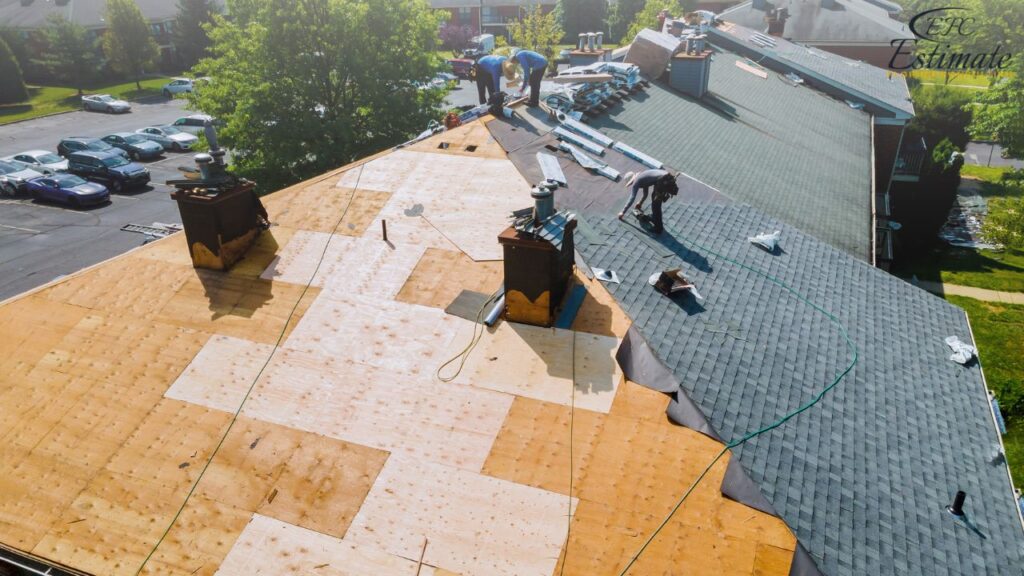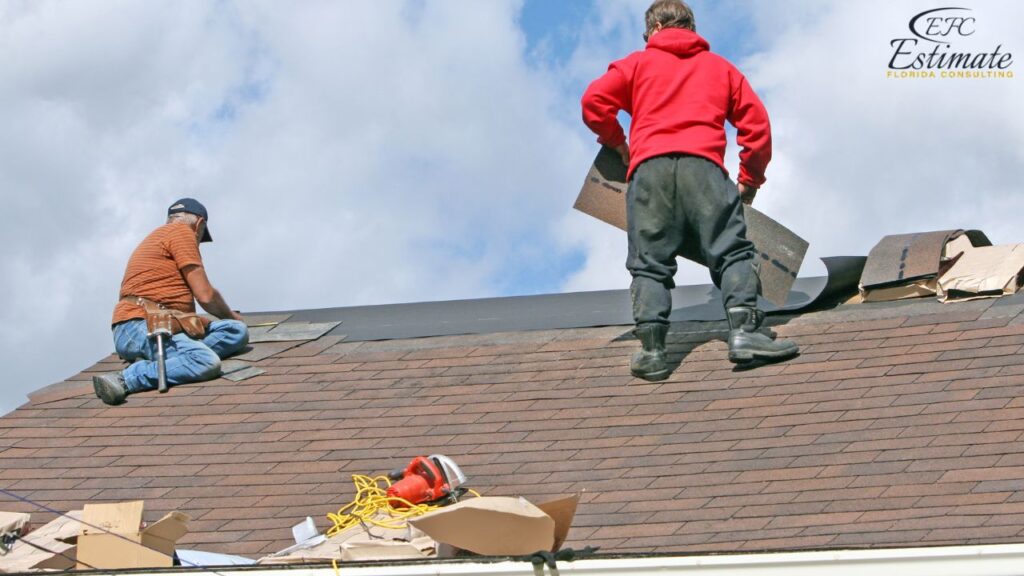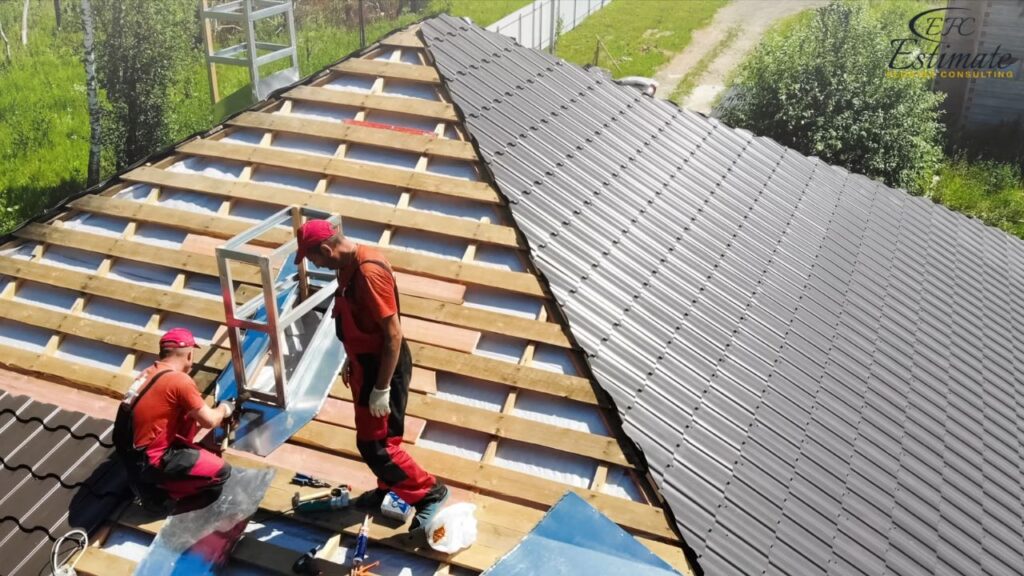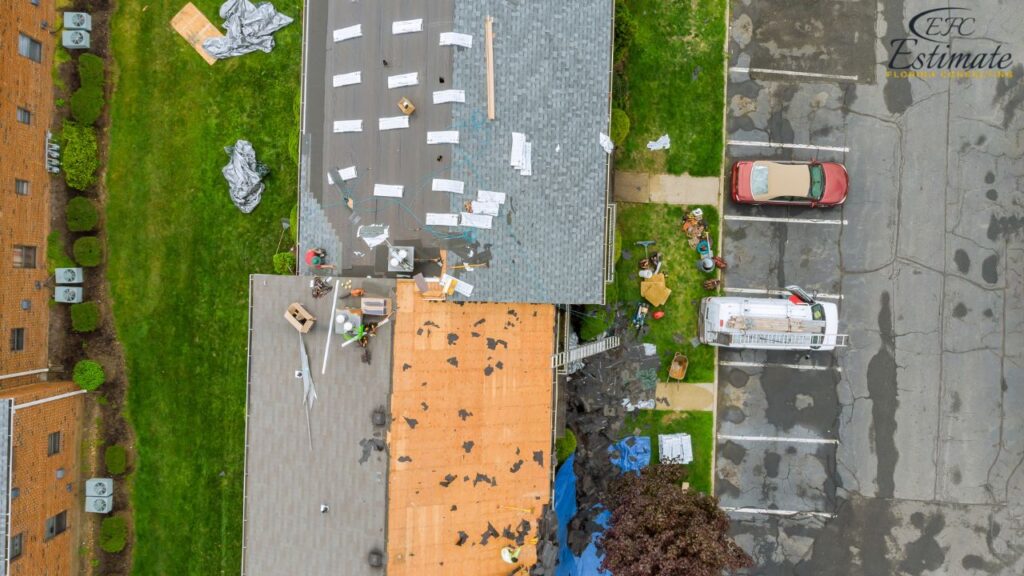How Much Does It Cost to Replace a Roof on a 2,200 Square Foot House?
Replacing a roof on a 2,200 sq.ft. house typically costs between $21,450 and $85,800, depending on the roofing material. Asphalt shingles range from $12,870 to $25,740, metal roofing from $25,740 to $51,480, tile roofing from $32,890 to $65,780, wood shingles from $21,450 to $42,900, and slate roofing from $42,900 to $85,800. These costs include materials, labor, and additional expenses such as permits and structural repairs. Labor costs vary by roof complexity, from $8,580 to $34,320. Investing in quality materials and skilled labor ensures a durable and aesthetically pleasing roof that enhances your home’s value.

Cost Breakdown for Replacing a 2,200 sq.ft. Roof
Materials
Here’s a breakdown of the estimated material costs for different roofing types:
Roofing Material | Cost per Sq Ft (in dollars) | Total Cost for 2,200 Sq Ft (in dollars) |
Asphalt Shingles | $5.85 – $11.70 | $12,870 – $25,740 |
Metal Roofing | $11.70 – $23.40 | $25,740 – $51,480 |
Tile Roofing | $14.95 – $29.90 | $32,890 – $65,780 |
Wood Shingles/Shakes | $9.75 – $19.50 | $21,450 – $42,900 |
Slate Roofing | $19.50 – $39.00 | $42,900 – $85,800 |
The material cost is a significant part of the total expense. Choosing the right material involves balancing durability, aesthetic appeal, and budget considerations. For example, while asphalt shingles are the most affordable option, materials like slate and metal offer superior durability and long-term value despite their higher upfront costs. Furthermore, the choice of material can affect the home’s energy efficiency, maintenance requirements, and overall aesthetic appeal. It’s important to weigh these factors carefully to select a roofing material that meets your needs and budget.
Labor
Labor costs can vary based on the complexity and pitch of the roof. Here’s an estimate of the labor costs:
Roof Complexity | Labor Cost per Sq Ft (in dollars) | Total Labor Cost for 2,200 Sq Ft (in dollars) |
Simple | $3.90 – $7.80 | $8,580 – $17,160 |
Moderate | $7.80 – $11.70 | $17,160 – $25,740 |
Complex | $11.70 – $15.60 | $25,740 – $34,320 |
Labor costs are influenced by the roof’s design and the skill level required for the installation. Simple roofs with minimal angles and slopes will cost less in labor compared to more complex designs with multiple facets and steep pitches. Additionally, labor costs can vary based on the contractor’s experience and the local market rates. It’s crucial to hire experienced and skilled roofers to ensure the quality and longevity of the installation. Proper installation techniques can prevent future problems such as leaks and structural damage.
Additional Costs
Additional costs can include permits, removal of old roofing, and any necessary repairs to the roof structure. Here’s an estimate of these additional costs:
Additional Component | Estimated Cost (in dollars) |
Permits | $650 – $1,950 |
Removal of Old Roofing | $1,950 – $3,900 |
Structural Repairs | $1,300 – $6,500 |
Miscellaneous Supplies | $650 – $1,300 |
These additional costs can add up, so it’s essential to factor them into your overall budget. Permits are necessary to ensure that the roofing work complies with local building codes. Removing old roofing material can be labor-intensive and requires proper disposal. Structural repairs are crucial to ensure that the new roof has a solid foundation, preventing future issues. Additionally, miscellaneous supplies such as fasteners, sealants, and underlayment can also contribute to the overall cost. Proper planning and budgeting for these additional expenses can help avoid surprises and ensure the project stays on track.

Choosing the Right Roofing Contractor
Selecting a reputable roofing contractor is vital to the success of your roof replacement project. Look for contractors with positive reviews, proper licensing, and adequate insurance coverage. Obtain multiple quotes and compare the scope of work, materials, and warranties offered. A trustworthy contractor will provide a detailed written estimate and be transparent about costs and timelines. Ensuring that your contractor has a proven track record can prevent potential issues and ensure a smooth roofing project. Additionally, it’s important to check for certifications from industry organizations and ask for references from past clients. A reliable contractor will also offer a clear contract outlining the terms of the project, including the payment schedule, timeline, and warranty details.
Roof Warranty
When replacing your roof, consider the warranty offered by the roofing material manufacturer and the roofing contractor. A comprehensive warranty can provide peace of mind and protect your investment. Manufacturer warranties typically cover material defects, while contractor warranties cover workmanship. Understanding the terms and duration of these warranties can help you choose the best option for your needs. Additionally, some warranties offer extended coverage for an additional cost, providing further protection against future issues. Reviewing and comparing warranty options ensures you select a reliable roofing solution. It’s also important to understand the maintenance requirements and any conditions that might void the warranty, such as improper installation or lack of regular inspections.
Energy Efficiency
Investing in energy-efficient roofing materials can lead to long-term savings on heating and cooling costs. Reflective roofing materials, for example, can reduce heat absorption and lower your energy bills. Cool roofs, which are designed to reflect more sunlight and absorb less heat, can improve the energy efficiency of your home, especially in hot climates. Additionally, proper insulation and ventilation in your roofing system can enhance energy efficiency and indoor comfort. Choosing materials with high energy efficiency ratings can also qualify you for tax credits or rebates, further reducing the overall cost of the roof replacement.

Furthermore, energy-efficient roofing can help reduce your home’s carbon footprint and contribute to environmental sustainability.
Environmental Impact
If environmental sustainability is a priority for you, consider choosing eco-friendly roofing materials. Some roofing options, like metal and slate, are recyclable and have a lower environmental impact compared to traditional asphalt shingles. Additionally, certain roofing materials can be sourced sustainably, and some manufacturers offer products made from recycled content. Evaluating the environmental impact of your roofing choice can help you make a decision that aligns with your values. Sustainable roofing options can also enhance your home’s energy efficiency and reduce your carbon footprint. Furthermore, choosing environmentally friendly materials can contribute to green building certifications and enhance the overall sustainability of your home.
Roof Ventilation
Proper roof ventilation is critical to the longevity and performance of your roof. Adequate ventilation helps regulate temperature and moisture levels in the attic, preventing issues like mold growth and ice dams. When replacing your roof, ensure that your contractor includes proper ventilation solutions, such as ridge vents, soffit vents, and attic fans. Effective ventilation can improve energy efficiency and extend the life of your roofing materials. Additionally, proper ventilation helps maintain indoor air quality and prevents structural damage caused by excess moisture. Consulting with your contractor about the best ventilation options for your roof can ensure optimal performance and longevity.
Impact of Local Building Codes
Local building codes and regulations can impact the cost of your roof replacement. These codes may dictate specific materials, installation methods, and safety standards that must be adhered to. Compliance with local codes may require additional inspections and modifications, adding to the overall cost. It’s essential to work with a contractor who is familiar with local building codes to ensure that your roof replacement meets all regulatory requirements. Additionally, understanding local codes can help avoid potential fines, delays, and complications during the project. Staying informed about any updates or changes to building codes can also ensure long-term compliance and safety.
Potential for Insurance Coverage
In some cases, your homeowner’s insurance policy may cover part or all of the cost of a roof replacement, particularly if the damage is due to a covered peril, such as a storm or fire. It’s important to review your insurance policy and discuss coverage options with your insurance provider. Filing a claim for roof replacement can help offset the cost, making the project more affordable. Keep detailed records of inspections, estimates, and repairs to support your insurance claim. Additionally, understanding the claims process and working with a contractor experienced in handling insurance claims can streamline the process and ensure you receive the coverage you’re entitled to.
Download Template For Roof Replacement Project Breakdown
- Materials list updated to the zip code
- Fast delivery
- Data base of general contractors and sub-contractors
- Local estimators

Factors Influencing the Cost of Roof Replacement
Type of Roofing Material
The type of roofing material chosen plays a significant role in the overall cost of the project. Here are some common options:
- Asphalt Shingles: Asphalt shingles are the most common roofing material due to their affordability and ease of installation. They typically cost between $4.50 and $9 per square foot. Asphalt shingles come in various styles and colors, allowing homeowners to choose a look that complements their home’s exterior. They offer decent durability and can last 20-30 years with proper maintenance. Replacing asphalt shingles is straightforward, making it a cost-effective option. Moreover, asphalt shingles are relatively easy to repair and replace in case of damage, making them a practical choice for many homeowners. Their widespread availability means that replacement materials are easy to source, reducing downtime during repair projects.
- Metal Roofing: Metal roofs are durable and energy-efficient, but they come at a higher cost, ranging from $9 to $18 per square foot. Metal roofing is known for its longevity, often lasting 40-70 years. It is also fire-resistant and can reflect solar radiant heat, which can reduce cooling costs by up to 25%. Replacing a metal roof involves more specialized labor and tools, which can increase installation costs. However, the long-term savings on energy bills and the minimal maintenance required can offset the initial investment, making metal roofing an attractive option for many. Additionally, metal roofs are available in various styles and colors, providing homeowners with a wide range of aesthetic choices.
- Tile Roofing: Tile roofs offer a distinctive look and excellent durability. They are more expensive, with costs between $11.50 and $23 per square foot. Tile roofing is highly durable, resistant to weather extremes, and can last up to 100 years. It also provides excellent insulation, which can help reduce energy costs. Replacing tile roofing is labor-intensive due to the weight and fragility of the tiles, requiring skilled contractors. The aesthetic appeal and longevity of tile roofs make them a popular choice in regions with hot climates and for homes with Mediterranean or Spanish architectural styles. The natural thermal mass of tiles helps in maintaining a stable indoor temperature, contributing to energy efficiency.
- Wood Shingles/Shakes: Wood shingles provide a natural aesthetic but require more maintenance. They cost between $7.50 and $15 per square foot. Wood shingles offer a rustic and charming appearance and can last 30-40 years with proper care. However, they are more susceptible to fire and may require treatments to enhance fire resistance. Replacing wood shingles involves careful handling to ensure proper installation and longevity. Despite their higher maintenance needs, wood shingles are favored for their natural beauty and ability to blend seamlessly with the environment. Additionally, treated wood shingles can offer enhanced durability and resistance to insects and rot.
- Slate Roofing: Slate is a high-end roofing material known for its longevity and beauty. It is the most expensive option, ranging from $15 to $30 per square foot. Slate roofs can last over 100 years and are highly resistant to fire, water, and weather. They also add a classic, elegant look to any home. Replacing slate roofing is complex and requires experienced contractors due to the weight and precision needed for installation. The durability and timeless appeal of slate make it an excellent investment for those seeking a premium roofing solution that can enhance the value and appearance of their home. Furthermore, slate roofs require minimal maintenance and are resistant to mold and mildew, contributing to their long lifespan.
Roof Complexity
The complexity of your roof’s design can affect labor costs. Roofs with multiple slopes, angles, and features like chimneys or skylights require more labor and time to replace, increasing the overall cost. Complex roof structures often demand specialized skills and additional safety precautions, contributing to higher labor costs. A simple, single-slope roof will generally be less expensive to replace than a multi-slope, intricate roof with dormers and valleys. The architectural style and design intricacies can make a significant difference in labor hours required and the overall project timeline.

Additionally, complex roof designs often necessitate more precise measurements and custom cutting of materials, which can further add to the labor costs. Ensuring that all unique elements of the roof are properly sealed and integrated is crucial to prevent leaks and other issues.
Roof Pitch
The pitch or steepness of your roof also influences the cost. Steeper roofs are more challenging and hazardous to work on, leading to higher labor costs. Roofing contractors may charge a premium for working on steep roofs due to the increased risk and need for specialized equipment and safety measures. Additionally, steeper roofs often require more materials, further increasing the overall cost. The steeper the pitch, the more time and effort it takes to complete the job safely and effectively. Understanding the impact of roof pitch on labor and materials helps in accurately estimating the total cost. It’s important to consider that steep roofs can provide better water runoff and increased attic space, which can be beneficial in certain climates and home designs. Properly managing the installation on steep roofs requires additional safety protocols to protect workers from falls.
Existing Roof Condition
The condition of your existing roof plays a role in the total cost. If the underlying structure is damaged, additional repairs will be necessary before the new roof can be installed. Removing the old roofing material and disposing of it properly can also add to the cost. In some cases, structural damage may require extensive repairs or reinforcements, further increasing the overall expense. If there are issues such as rotting wood, water damage, or mold, these will need to be addressed before the new roof can be installed, adding to both labor and material costs. A thorough inspection of the existing roof condition helps in identifying potential challenges early in the planning process. Addressing these issues upfront can prevent future problems and ensure the new roof’s longevity and performance. Ensuring a solid foundation for the new roof is critical for its long-term success and durability.
Geographic Location
Labor and material costs vary by region. Areas with a higher cost of living or greater demand for roofing services may see higher overall costs. Local climate conditions can also influence the choice of roofing materials and their associated costs, with some regions requiring more weather-resistant options. For example, areas prone to hurricanes or heavy snowfall may necessitate stronger, more durable roofing materials, which can increase the overall expense. Additionally, the availability of materials and local labor rates can vary significantly, impacting the total cost of the project. Understanding regional cost variations allows for better financial planning and budgeting.

It’s also essential to consider any local building codes or regulations that may affect the roofing project, ensuring compliance and avoiding potential fines or delays. Local environmental factors, such as high humidity or salt exposure near coastlines, can also influence the choice of materials.
Existing Roof Condition
The condition of your existing roof plays a role in the total cost. If the underlying structure is damaged, additional repairs will be necessary before the new roof can be installed. Removing the old roofing material and disposing of it properly can also add to the cost. In some cases, structural damage may require extensive repairs or reinforcements, further increasing the overall expense. If there are issues such as rotting wood, water damage, or mold, these will need to be addressed before the new roof can be installed, adding to both labor and material costs. A thorough inspection of the existing roof condition helps in identifying potential challenges early in the planning process. Addressing these issues upfront can prevent future problems and ensure the new roof’s longevity and performance. Ensuring a solid foundation for the new roof is critical for its long-term success and durability.
Cost-Saving Tips
Choose Cost-Effective Materials
Selecting roofing materials that balance cost, durability, and aesthetic appeal can help you save money. Asphalt shingles are a popular, cost-effective option that provides good durability and a range of styles. While higher-end materials like metal and slate offer long-term benefits, asphalt shingles can be a practical choice for budget-conscious homeowners. Additionally, considering composite materials that mimic the look of more expensive options can provide the desired aesthetic at a lower cost. It’s also important to shop around and compare prices from different suppliers to find the best deals on materials.
Schedule Off-Season Installation
Roofing contractors are typically busiest during the summer and early fall. Scheduling your roof replacement during the off-season can sometimes result in lower labor costs due to decreased demand. Off-season scheduling can also lead to shorter wait times for your project to start, as contractors have more availability during these periods. Planning your roofing project for late fall or early spring can take advantage of reduced competition for contractor services. Additionally, off-season installation can sometimes qualify for discounts or promotions offered by contractors looking to fill their schedules.
Obtain Multiple Quotes
Getting multiple quotes from reputable roofing contractors can help you find the best price for your project. Make sure to compare the scope of work, materials, and warranties offered by each contractor. Obtaining detailed, written estimates from several contractors allows you to make an informed decision and negotiate better terms. Additionally, reading reviews and checking references can ensure you select a contractor with a track record of quality work. It’s also helpful to ask for referrals from friends, family, or neighbors who have had similar projects done.
Get 5 New Leads Next 7 Days With Our System
- Multi-Family House
- Single-Faimly House
- Modern House
- Duplex
- Ranch House
- Bungalow
Consider Long-Term Savings
Investing in higher-quality materials or energy-efficient roofing options can result in long-term savings on maintenance and energy bills. For example, metal roofs can last significantly longer than asphalt shingles and may reduce cooling costs due to their reflective properties. Considering the total cost of ownership, including potential savings on energy and maintenance, can help you make a more cost-effective choice. Additionally, durable materials may require fewer repairs and replacements over time, providing further savings. It’s important to factor in the long-term benefits and potential return on investment when choosing roofing materials.
Do Some of the Work Yourself
If you have the necessary skills and safety equipment, consider doing some of the preparatory work yourself, such as removing old shingles or disposing of debris. This can reduce labor costs, although it is essential to ensure that any DIY work meets safety and quality standards. Consulting with your contractor about what tasks you can handle can provide clarity on how much you can save without compromising the project’s quality and safety. Additionally, taking on some of the work yourself can give you a better understanding of the project’s scope and requirements.
Conclusion
Replacing a 2,200 square foot roof is a substantial investment, but it is essential for maintaining the integrity and value of your home. By understanding the various costs involved and the factors that influence these costs, you can make informed decisions and budget effectively for your roofing project. Investing in quality materials and skilled labor ensures a durable and aesthetically pleasing roof that will protect your home for years to come. Properly planning and budgeting for your roof replacement can help you avoid unexpected expenses and ensure the project is completed on time and within budget. Making well-informed choices about materials, contractors, and project timing can lead to a successful roofing project that enhances your home’s value and comfort. Moreover, a well-executed roof replacement can provide peace of mind, knowing that your home is protected from the elements and structural damage, ultimately contributing to your family’s safety and well-being.
FAQs
The cost to replace a 2,200 sq.ft. roof varies by material. Asphalt shingles range from $12,870 to $25,740, metal roofing from $25,740 to $51,480, tile roofing from $32,890 to $65,780, wood shingles from $21,450 to $42,900, and slate roofing from $42,900 to $85,800. These prices include materials, labor, and additional expenses.
Factors include the type of roofing material, roof complexity, roof pitch, existing roof condition, geographic location, and additional costs like permits and structural repairs.
A reputable contractor ensures quality installation, preventing future issues. Look for positive reviews, proper licensing, insurance coverage, and obtain multiple quotes to compare scope, materials, and warranties.
Manufacturer warranties cover material defects, while contractor warranties cover workmanship. Comprehensive warranties provide peace of mind and protect your investment. Some offer extended coverage for an additional cost.
Yes, energy-efficient materials reduce heating and cooling costs. Reflective materials and proper insulation improve energy efficiency and may qualify for tax credits or rebates.
Google Reviews



Process To Get Roof Replacement Cost Estimate Report
Here I am going to share some steps to get roof replacement cost estimate report.
-
You need to send your plan to us.
You can send us your plan on info@estimatorflorida.com
-
You receive a quote for your project.
Before starting your project, we send you a quote for your service. That quote will have detailed information about your project. Here you will get information about the size, difficulty, complexity and bid date when determining pricing.
-
Get Estimate Report
Our team will takeoff and estimate your project. When we deliver you’ll receive a PDF and an Excel file of your estimate. We can also offer construction lead generation services for the jobs you’d like to pursue further.

